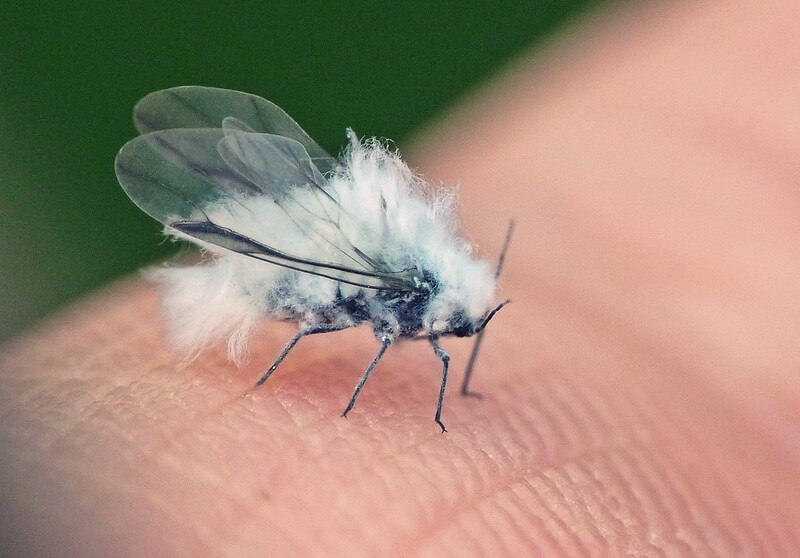Wooly Aphids…AKA “Blue Fuzzy-Butts”
By Byron Weber
Broadcast 9.1992, 10.2000, 10.2007, 10.2009, 10.2017, 10.12 & 10.15.2022

Wooly aphid (but we also like to call them “blue fuzzy-butts”!), photo by Ian Boyd, CC BY-NC 2.0.
Listen:
One of the sure signs of the arrival of autumn is the increase in the numbers of wool shirts and caps. But humans aren’t the only creatures who pull the wool on when the temperature drops. Soon we will be seeing the annual fall swarming of the wooly aphid, an insect about the size of a pinhead, flying about our yards dressed in a white coat of wool.
There are many different species of wooly aphid, each specific to a host tree. They inhabit alder and maple trees, ash trees, and birch trees like the paper birch in my yard.
The “wool” on the aphid’s body is really wax secreted from small glands, which causes the aphid to resemble a minute cottonball. It is this white speck moving through the air that attracts our attention. I have noticed that usually around the third week of September, there will be first one or two wooly aphids, then more, and finally one day a large swarm of these insects will be visible. The swarming process takes about two weeks to complete. If there is a cold period, however, the aphids will not appear, having died or disappeared into the leaf litter.
Swarming wooly aphids are the result of a most peculiar life cycle. In the spring, only females hatch and proceed to give birth to many more generations of wingless and winged females. The first wingless nymphs I notice on the leaves of the paper birch occur around the first week of June. The females give birth to more females until colder weather stops the growth of green plants. Then, a generation of males is produced. These males lack even mouthparts, and their sole purpose is to mate with a different generation of females. The fertilized females produce eggs that overwinter on the bark of the host plant, and the cycle continues.
This life cycle, dominated by generations of females, might be doubted by some, but rest assured…I’m not pulling the wool over anyone’s eyes.
Every week since 1991, Field Notes has inquired about Montana’s natural history. Field Notes are written by naturalists, students, and listeners about the puzzle-tree bark, eagle talons, woolly aphids, and giant puffballs of Western, Central and Southwestern Montana and aired weekly on Montana Public Radio.
Click here to read and listen to more Field Notes. Field Notes is available as a podcast! Subscribe on iTunes or wherever you listen to podcasts.
Interested in writing a Field Note? Contact Allison De Jong, Field Notes editor, at adejong [at] montananaturalist [dot] org or 406.327.0405.
Want to learn more about our programs as well as fun natural history facts and seasonal phenology? Sign up for our e-newsletter! You can also become a member and get discounts on our programs as well as free reciprocal admission to 300+ science centers in North America!












